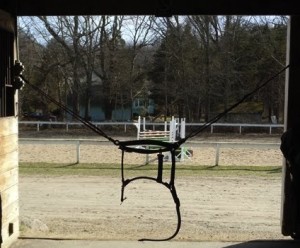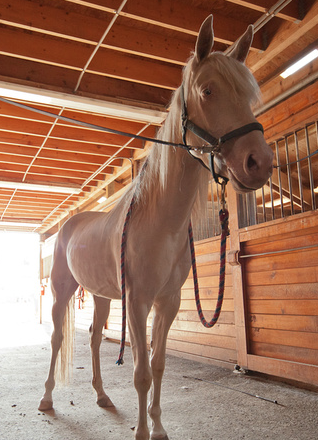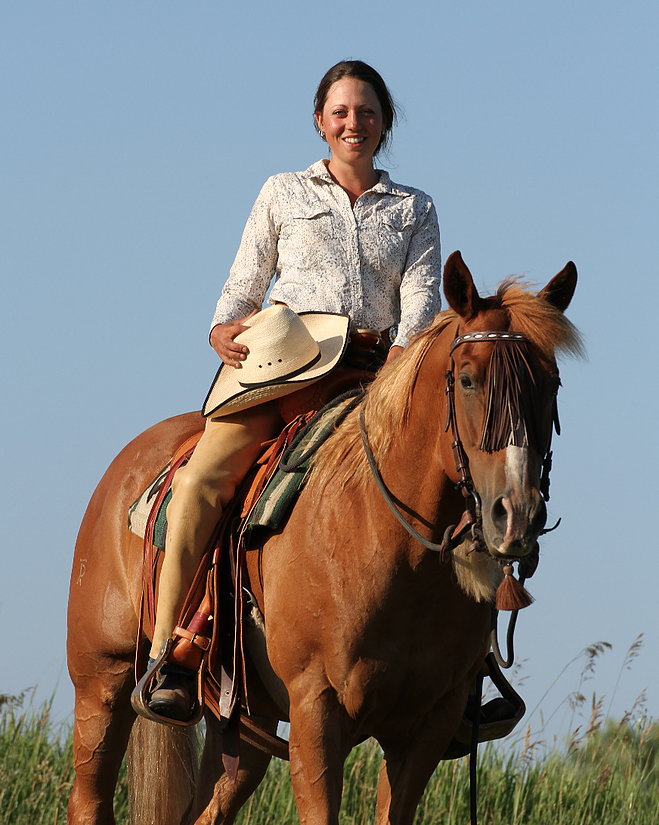2018 Best Horse Practices Summit presenter Amy Skinner is a frequent guest columnist for Cayuse Communications. Read more of her columns here.
Here, Skinner writes about the Cons of Cross Ties:
I recently sold a horse and delivered him to his new barn. I relayed the basic information of the four-year old gelding to his new owner: walk, trot, canter, trailers, clips so-so, etc. Basic four-year old stuff. I watched him get settled in, said my goodbyes, and was heading back to the truck, when she said, “oh by the way, I forgot to ask, and this is probably a dumb question – he cross ties right?”
 “Uh…not really. Never done it,” I said.
“Uh…not really. Never done it,” I said.
“Um…so how do I tie him?”
She stared at me blankly for a second, and I explained I rarely tie my horses for tacking up and routine handling. I prefer to teach my horses to stand on their own accord as much as possible, though I do tie on some occasions and believe horses should know how to tie safely. But cross tying as an option is something that doesn’t even cross my mind.
Read more about the Cons of Cross Ties.
What bothers me about cross tying is that it doesn’t make horse sense. When simply tied, if the horse is educated to release himself off of pressure, he can learn to stand safely without pulling back and getting himself into trouble. He has enough space usually to figure out how to untrack his hindquarters and step forward.
With a cross tie set up, the horse has pressure on both sides of his face, nowhere to go forward without pressure, and nowhere to go backward without pressure. Depending on the cross ties and their length, sometimes just standing there in the center maintains a steady pressure on the horse’s face (those clips are usually pretty heavy).
 Horses understand and learn by seeking relief, either from pressure, pain, or some type of stress – and the cross ties don’t provide a horse with a clear path toward this relief. There isn’t a place where they can stand calmly with slack in the rope generally, and the potential for injury and panic is high.
Horses understand and learn by seeking relief, either from pressure, pain, or some type of stress – and the cross ties don’t provide a horse with a clear path toward this relief. There isn’t a place where they can stand calmly with slack in the rope generally, and the potential for injury and panic is high.
If startled, upset, frustrated or antsy, the horse naturally wants to move. Imagine that something behind the horse startles or spooks him.
- His instinct is to go forward, but in cross ties he is met with pressure from both sides of his face.
- The only option for him to relieve this pressure is to go up, and depending on the footing (which in many barns is concrete).
- His potential for slipping or flipping backwards is quite high. I’ve seen too many horses flip themselves over in cross ties to ever consider this a safe option in my book again.
If something startles him from in front of him, backwards into the cross ties can be just as dangerous. Even a horse who has become habituated to the cross ties and can stand there quietly learns to lean into this pressure, making him heavier on the lead rope, heavy on the bridle, and heavy in his mind. He’s been dulled through repetitive lack of relief from pressure.
If your interest in cross ties is to keep your horse still and to prevent him from moving away from something he isn’t interested in, like a saddle, a vaccine, or a trim, there are more meaningful ways to educate a horse to stand relaxed. Cross ties make a horse feel trapped, and if he really isn’t interested in standing still he will find a way to move anyway.
If your goal is a relationship based on trust and communication, trapping your horse and forcing him to stand still is not a great way to achieve it. If I had to round up my students and force them to stay and listen in a lesson, it would probably reflect a bit about me and the way in which I present information to them. I hope they come because they’re interested and stay because it helps them, not because they feel they have to. If a horse can be taught in a way he can understand, he’ll often stand there on his own accord. Horses are generous that way.
In horsemanship, we seek lightness, and if your interest is working off a feel, cross ties can only muddy this goal. In dressage, jumping, and many western disciplines, we seek “forward, straight, and balanced.” The cross ties take out the forward, by teaching the horse to lean into pressure and discourage a horse’s forward movement.
Everything is closely tied together when working with horses, from the way he catches to the way he handles on the ground to how he rides. If a balanced, quiet ride is what you seek, then it starts here, on the ground, in all the tiny little details. If you can take the time to teach your horse to stand relaxed, you’ll be amazed at the difference in your horse’s demeanor in general.
Read more about the Cons of Cross Ties.

I agree. Never liked them and I don’t feel they are safe.
I too dislike cross ties and prefer that my horses learn to stand ground tied or tied to a blocker tie ring or with a quick release knot. My new horse has been just great learning to be ground tied. I think that he thinks it is fun!
totally agree. Friend’s horse flipped, crossties snapped, lead zinged out and clipped off part of her retina. Never ever do that
Totally agree! Thank you for a great article… again!
So yes, I realize that some people do cross ties to the point that a horse can not move there head but you can not make this assumption about every barn that uses cross ties. Only the show horses at my barn have cross ties in there stall. Even when we do tie them up this way they are done loose so they have free range of their head and can even move forwards and backwards quite a bit. The reason I use cross ties is because they are safer in contrast to a lead rope that can often get caught on things if the horse decides to move a lot.
Both cross tying and hard tying come with their own set of hazards. I have seen the worst of the worst in both situations. Done properly both practices can be safe and are appropriate depending on the location, situation, and horse. Maybe discuss how to be safe in the style you prefer or talk about the pros and cons of both. To write one off over the other does not open the door to what may be best for the overall situation.
Thanks for the recommendation. I wrote a bit about safe tying here http://www.nickernews.net/brent-graef-four.aspx#.WBE8tVduHzI
But I’d like to put out another clear one on safe tying. Good thoughts
A simple work around, snap cross ties to each other, then loop the lead rope around the cross tie snaps. Make enough loops to cause resistance should the horse decide to walk off (so it can “follow the feel” to find release by staying in the place it was tied). This way the feel on the horses face is the same as when straight tied, and the direction to release is clear. If you need to tie more securely than a looped rope, you can add a loop of baling twine to one of the snaps, then tie to the loop.
Great article. As an Equine Therapist I’ve worked on many horses who have had wrecks in the crossties. And they are REAL wrecks, often career-ending. Keep up the great work advocating for horses.
Thanks so much! my three horses learned and are learning to ground tie. They are free, unstalled, barefoot and bitless. Yes we still have behavior in the muddy mucky northeast mountain spring. Even more so because they are all youngish mares. Yes the three year old is still mouthy, shes a child. Relationships first always. I never chase to halter and they do not wear halters ever. Your words are so true. Please keep writing teaching and sharing. Jules Horsewalker
Interesting reading I’ve only just started cross tieing our horse as she was tied up normal in a bay to a bar & was pawing..then got a leg over the bar in front of her..panicked & reared & went right over the bar with head on ground & back legs stuck over the bar…when we got her up she was stuck & we had to cut the steel bar from underneath her…result was very lucky just cuts to back legs from rug straps….now I back her into the bay & cross tie her so she cant go over the bar again…any other suggestions please?
It sounds like your horse is wary of being tied in any situation. In this case, the issue is not the equipment but the care the owner makes to create a safe environment for the horse to be increasingly comfortable with being tied. Try not to put the horse in hazardous situations like the one you described. You’ll have to work hard to reinforce her comfort with being tied as she has had bad experiences and will need a steady hand and safe settings moving forward. Good luck
Hi – Extremely Importen for all horse owners to know the dangers of cross-ties. I’ve seen several near disasters with them especially when a horse falls.
But I still use cross ties on a regular basis but have Velcro releases on both sides. If a horse pulls back more than ~40 lbs, they break-out without falling or even much effort. Most stand quietly. But they have to understand good behavior when tied before I use cross ties.
I use Velcro crossties and love them. In fact, my trailer ties and ordinary ties are all velcro now. Note, my horses respect being tied. They never “panic pull” for no reason. But on the rare occasions that they have spooked and pulled, the spook was safe for me and them because they got “release” fast. This way, I don’t worry about reaching quick release snaps (which requires you to be present & maybe too near the horse) or breakaway halters. The velcro ties leave about 6″ dangling from the halter to grab if a horse starts to walk away. (My horses just stood still once they got release). Sadly, this past summer a lady tied her horse to her trailer with no release. The horse panicked and thrashed and the lady got caught by the horse falling down. The horse was fine, but the lady was in the hospital for 2 weeks. This would never have been so serious if she had used a safe release system. I know people have different favorite release systems. Just please pick your favorite one which does not require you to do anything but wait for the safe release and calm restored.
Thankyou for posting and Sharing this I have just shared this one a horse page in New Zealand trying to explain my side of why I don’t like cross tying
Leased a horse without first being able to have a conversation with the owner. I could not understand why the horse was constantly uneasy in the crosstie while getting gently groomed. Just met the owner today and learned that the horse had years ago panicked in the cross-ties and pulled them down (yes, the whole contraption), resulting in a gash in her shoulder that had stitches. Sounds traumatic to me. Thanks so much for your education on horses; no more cross-tying for us! ;]